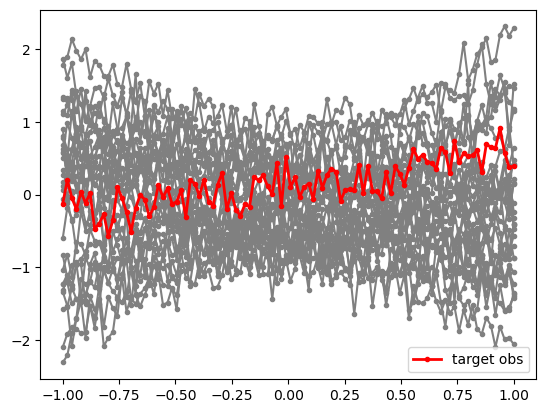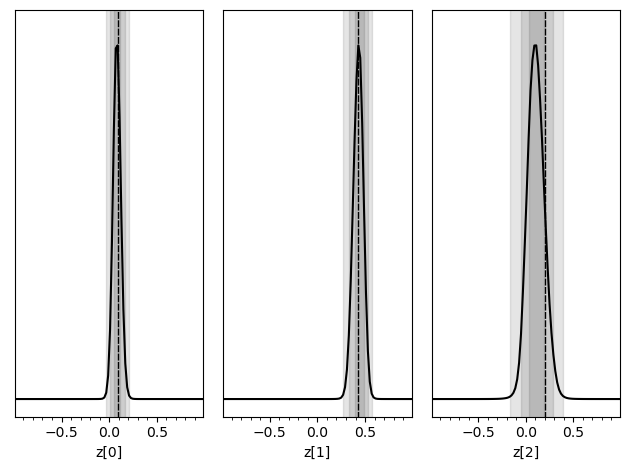This page was generated from notebooks/0C - Linear regression.ipynb.
C - Linear regression with Swyft#
Authors: Noemi Anau Montel, James Alvey, Christoph Weniger
Last update: 15 September 2023
Purpose: A first non-trivial example with vector-shaped data.
Key take-away messages: Low-dimensional linear regression tasks can be performed with standard Swyft functionality and networks.
Code#
[1]:
import numpy as np
import pylab as plt
import torch
import swyft
DEVICE = 'gpu' if torch.cuda.is_available() else 'cpu'
[2]:
torch.manual_seed(0)
np.random.seed(0)
We now consider a simple linear regression problem. Our data vector \(\mathbf x\) has now length 100, and we consider three model parameters \(\mathbf z\) which for the constant, linear and quatractic contribution.
where \(\mathbf y\) is a linear grid.
[3]:
N = 10_000 # Number of samples
Nbins = 100
z = np.random.rand(N, 3)*2 - 1
y = np.linspace(-1, 1, Nbins)
m = np.ones_like(y)*z[:,:1] + y*z[:,1:2] + y**2*z[:,2:]
x = m + np.random.randn(N, Nbins)*0.2
# We keep the first sample as observation, and use the rest for training
samples = swyft.Samples(x = x[1:], z = z[1:])
obs = swyft.Sample(x = x[0], z = z[0])
It is useful to visualize a subset of the training data, as well as our mock observation for which we will perform parameter inference below.
[4]:
for i in range(30):
plt.plot(y, samples[i]['x'], marker='.', color='0.5')
plt.plot(y, obs['x'], marker='.', color='r', lw = 2, label = 'target obs')
plt.legend(loc=0)
[4]:
<matplotlib.legend.Legend at 0x15ebe9d30>

Inference proceeds now as before, with the only difference that the size of the data vector (num_features) is now larger.
[5]:
class Network(swyft.SwyftModule):
def __init__(self):
super().__init__()
self.logratios = swyft.LogRatioEstimator_1dim(num_features = Nbins, num_params = 3, varnames = 'z')
def forward(self, A, B):
return self.logratios(A['x'], B['z'])
trainer = swyft.SwyftTrainer(accelerator = DEVICE, precision = 64)
dm = swyft.SwyftDataModule(samples)
network = Network()
trainer.fit(network, dm)
GPU available: True (mps), used: False
TPU available: False, using: 0 TPU cores
IPU available: False, using: 0 IPUs
HPU available: False, using: 0 HPUs
/Users/cweniger/opt/anaconda3/envs/native2/lib/python3.9/site-packages/pytorch_lightning/trainer/setup.py:200: UserWarning: MPS available but not used. Set `accelerator` and `devices` using `Trainer(accelerator='mps', devices=1)`.
rank_zero_warn(
/Users/cweniger/opt/anaconda3/envs/native2/lib/python3.9/site-packages/pytorch_lightning/loops/utilities.py:94: PossibleUserWarning: `max_epochs` was not set. Setting it to 1000 epochs. To train without an epoch limit, set `max_epochs=-1`.
rank_zero_warn(
The following callbacks returned in `LightningModule.configure_callbacks` will override existing callbacks passed to Trainer: ModelCheckpoint
| Name | Type | Params
-----------------------------------------------------
0 | logratios | LogRatioEstimator_1dim | 71.2 K
-----------------------------------------------------
71.2 K Trainable params
0 Non-trainable params
71.2 K Total params
0.570 Total estimated model params size (MB)
/Users/cweniger/opt/anaconda3/envs/native2/lib/python3.9/site-packages/pytorch_lightning/trainer/connectors/data_connector.py:224: PossibleUserWarning: The dataloader, val_dataloader 0, does not have many workers which may be a bottleneck. Consider increasing the value of the `num_workers` argument` (try 8 which is the number of cpus on this machine) in the `DataLoader` init to improve performance.
rank_zero_warn(
/Users/cweniger/opt/anaconda3/envs/native2/lib/python3.9/site-packages/pytorch_lightning/trainer/connectors/data_connector.py:224: PossibleUserWarning: The dataloader, train_dataloader, does not have many workers which may be a bottleneck. Consider increasing the value of the `num_workers` argument` (try 8 which is the number of cpus on this machine) in the `DataLoader` init to improve performance.
rank_zero_warn(
Reloading best model: /Users/cweniger/Documents/swyft/notebooks/lightning_logs/version_17/checkpoints/epoch=5-step=1500.ckpt
Inference is done as before, now targeting the mock observation from above. We plot the three one-dimensional posteriors side by side.
[6]:
prior_samples = swyft.Samples(z = np.random.rand(100_000, 3)*2-1)
predictions = trainer.infer(network, obs, prior_samples)
truth = {k: v for k, v in zip(["z[%i]"%i for i in range(3)], obs['z'])}
swyft.plot_posterior(predictions, ["z[%i]"%i for i in range(3)], truth=truth)
The following callbacks returned in `LightningModule.configure_callbacks` will override existing callbacks passed to Trainer: EarlyStopping, ModelCheckpoint
/Users/cweniger/opt/anaconda3/envs/native2/lib/python3.9/site-packages/pytorch_lightning/loops/epoch/prediction_epoch_loop.py:173: UserWarning: Lightning couldn't infer the indices fetched for your dataloader.
warning_cache.warn("Lightning couldn't infer the indices fetched for your dataloader.")

Exercises#
Estimate correlations and make corner plot.
[7]:
# Results go here
Add non-Gaussian noise to the data. For instance, you can use
ngn = np.random.poisson(lam = 3/Nbins, size = (N, Nbins))*5. This will produce on average 3 strong peaks in the data (a radio astronomer might think of RFI).
Run the network training again and see that parameter inference still works.
If you couldn’t use a neural net, what would you use instead?
[8]:
# Results go here
This page was generated from notebooks/0C - Linear regression.ipynb.